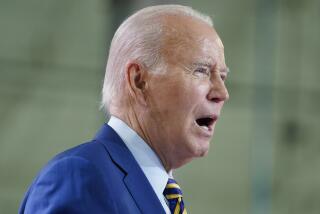Clinton Seeks to Greatly Expand Health Coverage
- Share via
WASHINGTON — President Clinton, seeking to take a slice out of the nation’s huge and growing uninsured population, proposed Wednesday stretching federal health coverage to 5 million low-income Americans who lack private insurance and do not qualify for existing government aid.
Clinton’s health insurance proposal is part of an ambitious plan to use the flood of tax revenue generated by the booming economy to assure the solvency of Social Security and Medicare and pay off the vast national debt within 15 years. It is also aimed at deflecting Republican efforts to return much of the surplus to taxpayers--and to bolster a similar proposal by Vice President Al Gore in his run for the Democratic presidential nomination.
Clinton said that his health plan, which would cost $138 billion over 10 years, would be the biggest expansion in health insurance since Medicare was created in 1965.
However, the modest share of the 44 million uninsured whom his plan would reach underscores how intractable is the problem of the uninsured. Ever since Congress rejected Clinton’s sweeping plan for universal health insurance in 1994, the president has moved cautiously.
“This administration did make a major push in the first term for universal coverage,” said a senior administration official. “Since then, we’ve tried to expand coverage in a cost-effective and realistic way so that we could move incrementally toward that goal.”
The centerpiece of the plan proposed by Clinton builds on a joint federal and state program that insures children in low-income families. That program was created by Congress in 1997 with strong bipartisan support.
Clinton’s new plan would extend coverage to the parents of these children. The subsidized insurance would be available to families with incomes of as much as $33,400 for a family of four.
The proposal was greeted favorably by Republicans and the health insurance industry, as well as by advocates for the uninsured.
Diane Rowland of the Kaiser Commission on Medicaid and the Uninsured said that the plan has the virtue of reaching the most vulnerable. “If you’re designing an incremental strategy to improve coverage, then the next step is to reach those . . . adults who are not covered,” she said. “They are an extremely needy group.”
“The president is working from the concept of building on what works, through supporting both the employer-based system and the public programs that help the people who are neediest,” said Chip Kahn, president of the Health Insurance Assn. of America, a vehement opponent of Clinton’s earlier universal health care proposal.
“Harry and Louise,” the couple featured in television commercials used by Kahn’s group to assail the Clinton plan in 1994, are back, but this time they are calling for a bipartisan approach to covering the uninsured. At a briefing for reporters Wednesday, Clinton joked that he would welcome Harry and Louise to the White House.
“I thought they were pretty effective last time, and we ought to be on the same side . . ,” he said. “We could have a little press conference, a Harry and Louise press conference, endorsing this expansion of health coverage.”
Republicans in Congress appear ready to consider Clinton’s proposal seriously, in part because they have few legislative accomplishments to cite when they face reelection in November. House Speaker J. Dennis Hastert of Illinois has said repeatedly that he wants to expand coverage for the uninsured.
Oddly, Clinton’s plan probably gets its most tepid support from House Democrats. Although they are from the president’s party, their top priority for 2000 is regaining majority control of the House in the November elections. They believe that the less Republicans are able to accomplish, the better for Democrats in November.
Clinton’s proposal would:
* Expand the Children’s Health Insurance Program so that the parents of children eligible for subsidized coverage could be covered themselves. To qualify, states would have to cover children in families up to twice the poverty line ($33,400 for a family of four).
* Allow the uninsured ages 55 to 65 to buy into Medicare and help them to afford it through a tax credit equal to 25% of the premium.
* Allow states to provide health insurance for legal immigrants who entered the United States after the enactment of welfare reform. The uninsured rate for Latinos, many of whom are legal immigrants, is 35%, twice the national rate.
* Offer workers who leave their jobs but not their health plans a tax credit worth 25% of the cost of the full premium.
More to Read
Get the L.A. Times Politics newsletter
Deeply reported insights into legislation, politics and policy from Sacramento, Washington and beyond. In your inbox twice per week.
You may occasionally receive promotional content from the Los Angeles Times.










